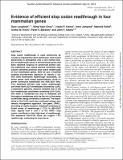Evidence of efficient stop codon readthrough in four mammalian genes
Author(s)
Loughran, Gary; Chou, Ming-Yuan; Ivanov, Ivaylo P.; Jungreis, Irwin; Kellis, Manolis; Kiran, Anmol M.; Baranov, Pavel V.; Atkins, John F.; ... Show more Show less
DownloadLoughran-2014-Evidence of efficien.pdf (2.393Mb)
PUBLISHER_CC
Publisher with Creative Commons License
Creative Commons Attribution
Terms of use
Metadata
Show full item recordAbstract
Stop codon readthrough is used extensively by viruses to expand their gene expression. Until recent discoveries in Drosophila, only a very limited number of readthrough cases in chromosomal genes had been reported. Analysis of conserved protein coding signatures that extend beyond annotated stop codons identified potential stop codon readthrough of four mammalian genes. Here we use a modified targeted bioinformatic approach to identify a further three mammalian readthrough candidates. All seven genes were tested experimentally using reporter constructs transfected into HEK-293T cells. Four displayed efficient stop codon readthrough, and these have UGA immediately followed by CUAG. Comparative genomic analysis revealed that in the four readthrough candidates containing UGA-CUAG, this motif is conserved not only in mammals but throughout vertebrates with the first six of the seven nucleotides being universally conserved. The importance of the CUAG motif was confirmed using a systematic mutagenesis approach. One gene, OPRL1, encoding an opiate receptor, displayed extremely efficient levels of readthrough (∼31%) in HEK-293T cells. Signals both 5′ and 3′ of the OPRL1 stop codon contribute to this high level of readthrough. The sequence UGA-CUA alone can support 1.5% readthrough, underlying its importance.
Date issued
2014-07Department
Massachusetts Institute of Technology. Computer Science and Artificial Intelligence Laboratory; Massachusetts Institute of Technology. Department of Electrical Engineering and Computer ScienceJournal
Nucleic Acids Research
Publisher
Oxford University Press
Citation
Loughran, G., M.-Y. Chou, I. P. Ivanov, I. Jungreis, M. Kellis, A. M. Kiran, P. V. Baranov, and J. F. Atkins. “Evidence of Efficient Stop Codon Readthrough in Four Mammalian Genes.” Nucleic Acids Research 42, no. 14 (July 10, 2014): 8928–8938.
Version: Final published version
ISSN
0305-1048
1362-4962